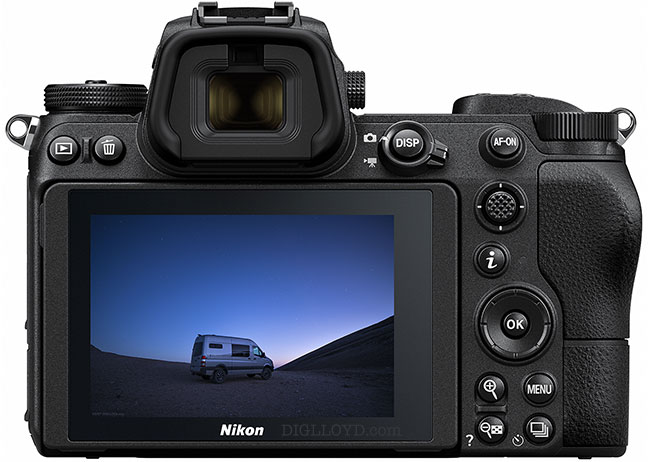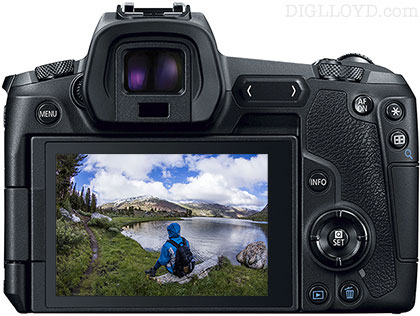Reader Comment: Transition to Mirrorless (UPDATED)
I offer consulting for choosing a camera system or computer system.
Reader Paul E writes:
I have been an active Nikon shooter for 15+ years. Although I have also owned Canon, Fujifilm and Olympus during that time, I have still considered myself to be a Nikon shooter. I have been pleased with Nikon quality, both images and gear. Bodies like the D700, D800E and D850 have been terrific, as have many Nikkor lenses been amazing.
 Nikon Z7
Nikon Z7I first tried mirrorless in 2013 and have owned several mirrorless bodies and lenses of various persuasions since. I am now ready to make a complete transition to mirrorless and prefer not to use adapted lenses unless necessary. I am a travel, event, portrait, landscape and sports shooter - a little bit of everything. My $64 question is, knowing everything you have learned about mirrorless lenses, bodies, company commitments, innovation and financial trajectories, which single mount would you invest in when deciding among Canon, L-Mount, Nikon or Sony mirrorless? What would be your second choice?
I really don’t want or need any justification because that information is contained in the hundreds of tests you have performed and articles you have written over time. I am more interested in the synthesis that you are uniquely positioned to perform.
DIGLLOYD: Sony mirrorless is easily the best choice at this point, having used all the systems on the market extensively, excepting the very latest Canon EOS R5 which I’ll be reviewing as soon as I can get one.
Lens selection, focus tracking and Eye AF, pixel shift, resolution, and an aggressive update schedule and a broad ecosystem make it hard to recommend another mirrorless system at this point.
Obviously there can be overriding considerations (e.g., 8K video in the Canon EOS R5), but Sony is clearly the best choice in general.
Second choice: I’d go with Canon EOS R5 because of the outstanding lens line for pros—Nikon is targeting the prosumer market with lenses designed for a modest price point. But that may be a strength for some non-pro users.
Gary J writes:
 Canon EOS R
Canon EOS RI attempted the transition from Canon DSLRs to Sony mirrorless for months. I found Sony layout, complexity, etc. strange and too much to master. When Canon R camera came out I was delighted at the results and found it easy to transition to their mirrorless. Everything seemed so much more familiar.
Used the R mainly for macro (flowers). Now using the R5 for wildlife. The Animal Eye Focus greatly enhanced bird photography in particular. Look forward to your review of the R5.
Due to rapid battery depletion using two NH batteries and a grip is necessary. If battery charge is less than 60%, the R5 will only take single shots so two batteries are critical. The BG-R10 Grip for the R5 is quirky. If you insert a battery in grip so it is not properly secured and close the latch of the grip, the latch is automatically locked in the closed position. Dismantling the grip is necessary to remedy the situation. Paid $115 to camera repair shop to dismantle the battery grip.
DIGLLOYD: I sympathize with the difficulty of switching between systems—I’ve had to do that for 12 years now, frequently.
But familiarity is not really an argument—different is not the same as less good; it might be better (or worse). On the far-worse front are the Leica and Hasselblad designs, which no matter how familiar I got with them (a month is plenty), they remain obstinate time-wasting design failures that cannot be overcome in any way.
Canon and Nikon and Sony know what they are doing and all are good. Their weaknesses vary, but I will not tolerate AF errors or crap-grade Eye AF (Nikon Z7). And as much as I’ve complained about Sony design over the years, the Sony A7R IV is now the most configurable and responsive camera I’ve yet used (Canon EOS R5 TBD), and my recent experience with Nikon Z7 make me say emphatically that Sony is far preferable to Nikon—on the Z7 you cannot even program key items into buttons or My Menu—so frustating.
And—this is a BIG point for any pro—Canon and Nikon lack 3rd-party lenses, a huge 'fail' since the Sigma and Zeiss offerings on Sony (and many other vendors) give you a far wider range of choices, some of which are the best available.
Gary J follows up:
I am responding to your comments on my comment about the above matter. A major reason I subscribe to your website is that you are perhaps the most exhaustive, meticulous analyst of photographic equipment functioning and of the images they produce. You definitely have a sense of arete. You focused on getting the best images possible from the tools available. If there is some flaw or weakness in a lens or camera, you will find them if anyone will.
However, I am a hobbyist retiree who enjoys photographic outings and the images produced. My primary goal in photography is my enjoyment. I like being in the outdoors and later take aesthetic pleasure in viewing the images produced. For me there is a trade off between effort and enjoyment. Often I am focused in recording animal behavior which I often find most interesting.
Chelesa Northrup, part of a husband-wife team of photographers and photographic bloggers, echoes my sentiments in switching from Sony to Canon R and RF products. She finds the Canon R more familiar and intuitive than the Sony.
Thanks for all your hard work. Looking forward to your reviews of the R5 and eventually I hope the RF lenses.
DIGLLOYD: I 'get' it—a top priority is comfort with a system. My main point though was that for many users, a learning and adjustment period is necessary to become as comfortable with a new system as prior one—and that after that investment, another system might actually work out better—it all depends. I don't like the Canon EOS R buttons—tiny and very poor with gloves (just to give an example)—but I have not yet used the EOS R5.
I would also say that most "I don't like Sony" users have not ever seen the Sony A7R IV, which is easily the best yet—so a “don’t like Sony” viewpoint could be out of date and erroneous at this point, at least to some extent.
Terrence M writes:
I switched from the Nikon DSLR to Sony Mirrorless primarily for the Eye AF and it's fantastic. To use Nikkor G lens on the Sony Mirrorless, the Commlite ENF-E1 PRO Mount Adapter works well except the AF is slower, approximately half speed but it's accurate.
To clarify, I am not only using Nikkor G lenses with the adapter on the Sony, but I am also adding Sony G Master and Sigma Art to the mix. This way you are not forced into buying the Nikon mirrorless or selling the Nikkor G lenses.
DIGLLOYD: there are few to no Nikkor G lenses I’d want to waste my time with but if it floats one’s boat—I’m all good with it—and it shows how flexible Sony mirrorless is.
Roderick W writes:
I am in the position of many of your readers. 40 years a Nikon user. If and when should I transition to mirrorless? I used to favour manual focus lenses, but now my eyes need the help of AF. I used not to care about lens weight, but now with replacement leg joints and age related loss of fitness, I do care! Reluctantly the Otus 28 mm has to go as I do not take it on trips.
 Sony A7R IV
Sony A7R IVThe majority of my photographs are of plants in the wild and in the garden. The conditions are rarely appropriate for focus stacking – wind and no tripod carried in the field - so a single shot needs adequate depth of focus to convey the information about the plant. In film days the Nikkor Micro 55 mm f2.8 was my workhorse. Now on the D850 the Nikkor AF-S 24 mm f 1.8 G is my first choice. The choice of where to centre the AF is critical and I take 3 or 4 images of each subject. The camera AF is not totally consistent either!
Your current coverage of the 20 mm and 24 mm S lenses and the Z7 camera are very timely. I will probably wait at least a year however before making any move, unless I see evidence the results with the S lenses are much better than the G lenses for what I do. Your Green and Orange Pumpkins series with the Nikon AF-S 20 mm f/1.8G on the Nikon D810 was particularly instructive as a near subject with great depth. Similar comparisons between G and S lenses will probably have to wait until I hire a Z system to explore what is possible. Meanwhile I will read on with interest as you explore the mirrorless offerings.
DIGLLOYD: the DSLR is dead and half buried, with few reasons to use one anymore. However, the Nikon D850 remains a very fine camera (and a classic), and I would not rush out to buy a Nikon Z7 if the D850 is serving well or unless there are size/weight or other.
Using magnified Live View for focus should yield spot-on focus most every time.
The Nikon NIKKOR Z lenses are markedly superior to the G lenses in the color correction department—which can matter a LOT for any image with strongly out of focus areas, by avoiding the color pollution of secondary color, e.g., violet fringing and magenta/green color bokeh. In this regard the Nikon NIKKOR Z lenses are world-class and blow away most of the Nikon G lenses, indeed the NIKKOR Z lenses should be deemed APO, as they are far superior to most Leica APO (faux APO) lenses. The newer G lenses including the Nikon AF-S 20 mm f/1.8G are much improved so one might be reasonably happy using it with the Nikon FTZ lens adapter. But IMO it’s far better to make the move to native-mount lenses for those frequently used.
Depth of field has not changed. What has changed is resolving power and the circle of confusion (CoC) any given aperture delivers relative to the sensor pixel pitch (size of the pixel/photosite on the sensor). Resolution has risen so high that now an aperture of f/11 substantially degrades the image on cameras with 45MP sensors on up. But this is NOT new—it was the same with film, even if few people ever noticed.
Some newer cameras can shoot a short focus stack very quickly, so while wind is indeed an frustrating issue, if one pauses for a lull and initiates the stack, it can be successful.

NIKON D810 + 20.0 mm f/1.8 @ 20mm
[low-res image for bot]
































